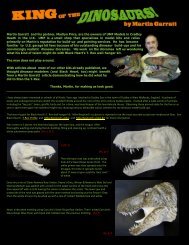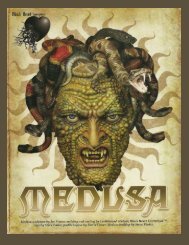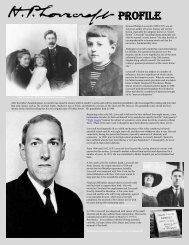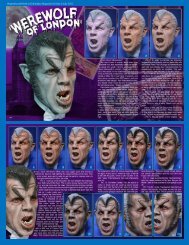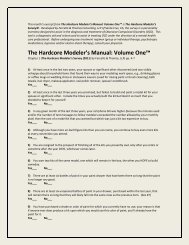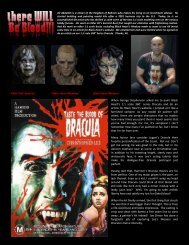Alien Profile - Black Heart Enterprises
Alien Profile - Black Heart Enterprises
Alien Profile - Black Heart Enterprises
Create successful ePaper yourself
Turn your PDF publications into a flip-book with our unique Google optimized e-Paper software.
<strong>Profile</strong><br />
Xenomorphology: The Creator<br />
H.R. Giger is a Swiss surrealist painter, sculptor and set designer. More<br />
than 20 books have been published about Giger’s art. But his most<br />
famous book, Necronomicon, published in 1977, served as the visual<br />
inspiration for director Ridley Scott’s <strong>Alien</strong>, Giger's first high-profile film<br />
assignment. His work on the film earned him the 1980 Oscar for the Best<br />
Achievement in Visual Effects for his designs of the film's title character,<br />
including all the stages of its lifecycle, and the film’s alien environments.<br />
His other well-known film work includes <strong>Alien</strong> 3 (1992), Species (1995),<br />
and Poltergeist II (1986).<br />
Giger’s illustrations/designs for “The Derelict”, “Space Jockey”, alien eggs, “facehugger”, “chestburster”, and the mature <strong>Alien</strong> have<br />
inspired sequel films, comic books and graphic novels, and an untold number of action figures, model kits, and high end collectibles.
Xenomorphology: The Films<br />
<strong>Alien</strong> (1979) introduced movie-goers to some of the most<br />
memorable characters in the history of cinema. The film’s main<br />
character was a smart, tough-minded woman, a survivor and a<br />
heroine. Sigourney Weaver, as Ripley, shattered stereotypes of<br />
women in horror and science fiction films. The universe created<br />
by <strong>Alien</strong> provided Ripley three more opportunities to kick some<br />
alien butt in <strong>Alien</strong>s (1985), <strong>Alien</strong> 3 (1992) and <strong>Alien</strong> Resurrection<br />
(1997). The latest chapter in the <strong>Alien</strong> film universe is Prometheus<br />
(2012) and is independent of the Ripley story-line. It does feature<br />
some familiar elements from the preceding films in the series.
Xenomorphology: The Organism Part 1<br />
As surprisingly new and fresh as Ripley was to film fans, so was the<br />
alien antagonist shocking to all of us monster lovers. H.R. Giger’s<br />
creature designs and the stages of the alien’s life-cycle helped reignite<br />
our interest in films with one of the most memorable film<br />
creatures in a generation, a convincing and truly frightening<br />
monster. In addition to the <strong>Alien</strong> series of films, <strong>Alien</strong> also gave<br />
birth to <strong>Alien</strong> vs. Predator (2004) and <strong>Alien</strong> vs. Predator: Requiem<br />
(2007) and Prometheus (2012).<br />
The life cycle of the aliens in the <strong>Alien</strong> films is loosely based on<br />
that of the ichneumon fly which lays its eggs in live caterpillars so<br />
that, when they hatch, they have an ample supply of fresh<br />
nourishment. Stage One of the alien life-cycle begins with an egg<br />
that becomes “alerted” when in the presence of a potential host.<br />
In Stage Two, the<br />
host is in striking<br />
distance, the egg<br />
opens, the facehugger<br />
emerges,<br />
attaches itself to<br />
the host and then<br />
implants an<br />
embryo.<br />
The host is immobilized and kept alive by the facehugger for a short<br />
period. While the face-hugger cannot be removed without harming<br />
the host, after a short time, the facehugger dies and falls off the<br />
host’s face. The host revives with no recollection of what has<br />
occurred. In Stage Three, the chest-burster exits the host’s body.<br />
Stage Four is the growth and maturation and the emergence of the fully grown xenomorph.
Xenomorphology: The Organism Part 2<br />
The <strong>Alien</strong> sequels instroduced other incarnations of the<br />
xenomorph. <strong>Alien</strong>s introduced the alien hive and an <strong>Alien</strong><br />
Queen who could lay hundreds of eggs. It showed an alien<br />
infestation that reduced a bustling, community of hundreds of<br />
working families and children to a colony of cocooned hosts<br />
for an army of hostile xenomorphs and their queen. Even wellarmed<br />
marines were unable to handle the alien horde.
Xenomorphology: The Organism Part 3<br />
In <strong>Alien</strong> 3 we learned that the xenomorph could also be hosted by our pets and/or our<br />
livestock. While the theatrical release featured the creature being birthed from a dog,<br />
as seen in the Director’s Cut of the film and in the still below, this xenomorph may<br />
have been birthed by an ox or a cow.<br />
<strong>Alien</strong> 3 also introduced us to the Queen <strong>Alien</strong> Face-<br />
Hugger and Queen <strong>Alien</strong> chestburster.
Xenomorphology: The Organism Part 4<br />
<strong>Alien</strong> Resurrection showed that an <strong>Alien</strong> Queen could be cloned and<br />
penned, and that her eggs and DNA could be harvested. We saw<br />
more examples of the xenomorph’s intelligence and how highly<br />
adaptive a life-form it is. We saw them swim, spit acid, plot and<br />
scheme.
Xenomorphology: The Organism Part 5<br />
<strong>Alien</strong> vs. Predator (2004) featured the<br />
xenomorphs from the <strong>Alien</strong> universe and<br />
an Earth-bound encounter with another of<br />
our favourite, hostile, extra-terrestrials, the<br />
Predator. We learned that this was the<br />
renewal of a centuries old Predator sport<br />
or ritual or both; we learned xenomorphs<br />
can survive the cold; we saw the <strong>Alien</strong><br />
Queen penned and her eggs harvested; we<br />
saw that the more technologically<br />
advanced, seemingly more intelligent<br />
Predators are no match for a determined<br />
horde of xenomorphs; we saw an <strong>Alien</strong><br />
Queen battle a Predator; and we saw a<br />
xenomorph hosted by another life-form,<br />
this time a full-grown Predator.
Xenomorphology: The Organism Part 6<br />
<strong>Alien</strong>s vs. Predator: Requiem (2007) re-united the centuries old<br />
adversaries in a battle in a small Colorado town where humans are<br />
caught unaware. The film introduced another variant of the<br />
xenomorph, a Predator-Xenomorph hybrid known as the Predalien.
Xenomorphology: The Organism Prelude<br />
Prometheus (2012) introduced audiences to a previously uncharted part of the <strong>Alien</strong> universe. The film may have answered questions<br />
raised by the original film more than 30 years ago about the “space jockey”. He was apparently from a race of technologically advanced<br />
“engineers” of life-forms and biological weapons. Prometheus suggested a purpose for the derelict ship and, possibly, the reason<br />
xenomorphs were created and the reason their eggs were stored in the ship. But, the film gave no clear answer as to the origin of the <strong>Alien</strong><br />
xenomorph from and its sequels. Was it a lethal life form discovered and then exploited as a biological weapon or as in the AVP films for<br />
sport? Or was it a genetically engineered life-form? Could the engineers of such a life-form also be the creators of man?<br />
The film also raised other questions. If the engineers created man, why did they do it? Where is their home world? Why did they leave<br />
clues to where they could be found? And, why were they so pissed off when we found them? Perhaps we’ll learn more and meet new lifeforms<br />
in Prometheus 2.




